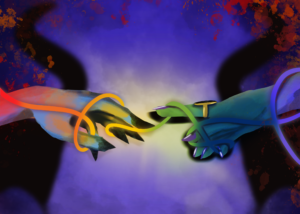When I saw that a new trailer for It: Chapter Two (2019) had been posted online yesterday, it took me a long time to build up the courage to watch it. The first movie absolutely terrified me and I assumed that just watching the trailer for the second film would give me enough nightmare fuel to last for a week. Boy was I wrong. Not that the It trailer isn’t scary, it definitely is, but the horrifying image that haunted my dreams last night wasn’t a shape-shifting demon clown. It was an unholy cross between person and cat brought to life by some of the most unsettling digital effects imaginable.
The new trailer for Cats (2019), which also dropped yesterday, features a collection of actors’ faces fused onto computer-generated human/cat hybrid bodies. The effect is technically seamless, accurately depicting what an anthropomorphized cat would probably look like, but it is also deeply disturbing. Seeing human lips, eyes, and noses sprouting out of a cat’s face creates a strange dissonance that distracts from anything else on the screen. I’ve watched this trailer several times now out of morbid fascination, but I honestly couldn’t tell you anything about it other than that the cats are horrifying. This is emblematic of the problem that Hollywood has with CGI. Computer-generated imagery has become so lifelike that almost anything a filmmaker desires can be made to look like it could exist in the real world, but that isn’t always a good thing.
The Cats trailer is only the latest example of a movie using hyper-realistic CGI to its detriment. In April, the trailer for Sonic the Hedgehog (2020) introduced fans to the muscular limbs, human teeth, and oddly proportioned eyes of the blue speedster. Negative reaction was so extreme that the studio delayed the release of the movie to replace Sonic with a character model that wouldn’t traumatize children. Disney’s “live action” remake of The Lion King (2019) released last weekend, attempting to completely redo the 1994 original with hyper-realistic CGI. According to early reviews, the effects are perfect but ultimately hamper the film—stripping emotions out of key scenes and creating a dissonant effect whenever the animals burst into song. Turns out real lions don’t have expressive faces. Or sing.
In each of these cases, the film would have been better served by either practical effects or more cartoony CGI. Cats should have just used practical costumes, perhaps using CGI to enhance them a bit or animate the tails, but not to computer generate the whole character. The audience would probably know they were costumes, but would quickly accept that and enjoy the film, instead of being horrified by the abominations shown in the trailer. On the other hand, both Sonic the Hedgehog and The Lion King should still have used CGI but made their characters less realistic. The audience instinctively knows that Sonic is fake, so trying to make him look more real just puts him in an awkward uncanny valley. A character model closer to the unrealistic proportions of the original video game would avoid forcing the audience to accept the uncomfortably human aspects of a “realistic” Sonic. A more cartoony character can also be more expressive, better conveying emotion to the audience and increasing the impact of the movie. You can see this distinction in the difference between the original The Lion King (1994) where the characters are anthropomorphized and very expressive and the remake of The Lion King where the characters look like the lion version of a hyper-realistic meh emoji. Realistic effects are supposed to make movies better and more immersive, but in these movies, they pull the audience out of the experience and make the movie worse.
This isn’t to say that hyper-realistic CGI is always a bad thing; one of the best film villains of last year was a purple space monster that would have been impossible without it, but it shouldn’t immediately be the go-to for all movies. Realistic CGI is only one tool that a filmmaker can use, along with practical effects, hand-drawn animation, and CGI that is deliberately more cartoony. Each of these techniques have their own advantages and drawbacks that should be considered before using them in a movie. A perfect example of this is Jurassic Park (1993), which used CGI to create wide shots, animatronics for close-ups, and animation for the DNA spokesperson in the park’s introduction video. In every situation, the correct tool was used to make the movie as immersive and impactful as possible. Unfortunately, in today’s movie-making industry it seems like realistic CGI is always the first choice, even when it doesn’t make sense. Cats, Sonic the Hedgehog, and The Lion King all show the consequences of filmmakers using realistic CGI when they didn’t need to, hurting the end product. To paraphrase Jurassic Park, they were so preoccupied with whether or not they could do something that they didn’t stop to think if they should do it.





